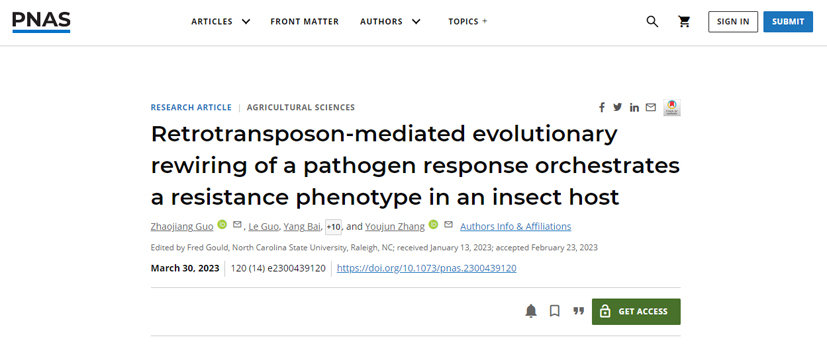Recently, the vegetable pest control innovation team, led by researcher Zhang Youjun of our institute, has made new progress in the field of genetic regulatory mechanisms underlying Bt resistance in Plutella xylostella. The study found that the crucial natural variation that mediates Bt resistance in P. xylostella is a retrotransposon SE2 insertion mutation in the upstream non-coding region of the key resistance gene MAP4K4, and clarified the Bt resistance regulatory network mechanism centered on SE2. The relevant content was published online under the title "Retrotransposon-mediated evolutionary rewiring of a pathogen response orchestrates a resistance phenotype in an insect host" in the Proceedings of the National Academy of Sciences of the United States of America (PNAS).

P. xylostella is one of the most devastating and cosmopolitan agricultural pests that damages cruciferous vegetable crops. The quality and yield of vegetables dropped sharply after damaged by P. xylostella and causing huge economic losses to agricultural production. Currently, the control of P. xylostella in the field mainly depends on the use of insecticides, however, P. xylostella is highly prone to developing resistance to various insecticides, making it a major challenge to effectively control them, and has become a long-standing problem in agricultural production. Bacillus thuringiensis (Bt) is a common bacterium in the soil, which has a poisonous effect on many pests. The insecticides or transgenic crops developed based on Bt bacteria are environmentally friendly and target-specific, and are widely used for pest control. However, with the irrational use of Bt pesticides and the large-scale promotion of Bt transgenic crops, pests quickly developed resistance to this biological control product. P. xylostella was the first agricultural pest documented to develop high-level resistance to Bt biopesticides in the field. Scientists have conducted in-depth research on the mechanism of Bt resistance with P. xylostella as the research object, and achieved fruitful research results. However, there are still many unresolved problems regarding the molecular mechanism of Bt resistance in P. xylostella.
Previous research by Zhang Youjun's team have demonstrated that elevated levels of insect juvenile hormone (JH) and ecdysone (20E) and their crosstalk can transcriptionally activate the mitogen-activated protein kinase (MAPK) signaling pathway in the BtR-1 resistance locus of P. xylostella, mediate transcription factors (TFs) to trans-regulate the transcript levels of multiple midgut receptor and nonreceptor paralogous genes, thus orchestrating inducible tolerance or resistance to the Bt toxin Cry1Ac in P. xylostella without growth penalty. Relevant research results have been published in internationally renowned journals, such as PLoS Genetics (2015, 2022), Nature Communications (2020, 2022), PLoS Pathogens (2021) and BMC Biology (2022).
In this study, using genetic mapping, Zhang Youjun's team identified the natural genetic variation that was significantly associated with Bt resistance in P. xylostella. The retrotransposon SE2 inserted in the promoter region of MAP4K4 gene significantly regulated the transcription of MAP4K4, and was tightly linked with Bt resistance in P. xylostella. Studies have shown that there is a response element (FRE) for the TF FOXO in the SE2, and FOXO can bind to this FRE mediated by insect hormones, and the two cooperate to upregulate the expression level of the target gene MAP4K4, thereby activating the MAPK signaling pathway to regulate the differential expression of downstream midgut genes, resulting in a stable and heritable high resistance phenotype to Bt in P. xylostella. The research results systematically elucidates the molecular genetic regulation network of Bt resistance mediated by the key genetic variation of retrotransposon SE2, which provides a new perspective for the study of molecular mechanisms of insecticide resistance. The identified SE2 genetic variation in this study can be used for real-time and rapid monitoring of Bt resistance levels of P. xylostella in field, providing important evidence for guiding the rational use of Bt insecticides in the field.

Fig. 1. A proposed model for the SE2-mediated rewiring of the Bt Cry1Ac toxin response pathway to deliver a resistance phenotype in P. xylostella.
Dr. Guo Zhaojiang, Dr. Guo Le, and Dr. Bai Yang are the co-first authors of this paper. Dr. Guo Zhaojiang and Dr. Zhang Youjun are the co-corresponding authors. This work was supported by the National Natural Science Foundation of China (32022074; 32221004; 32172458), the China Postdoctoral Science Foundation (2022TQ0369), the earmarked fund for CARS (CARS-23), the Beijing Key Laboratory for Pest Control and Sustainable Cultivation of Vegetables, and the Science and Technology Innovation Program of the Chinese Academy of Agricultural Sciences (CAASASTIP-IVFCAAS).
Related paper information: https://www.pnas.org/doi/10.1073/pnas.2300439120